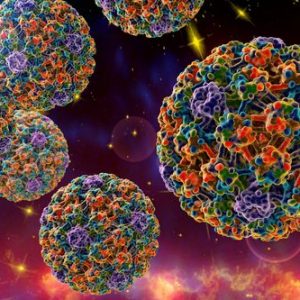HPV is considered as a predisposing factor of cervical cancer, but also as a provocateur of other types of cancer of the penis, the oropharynx, rectum. The global annual incidence of about 1.5 million
HPV infection is one of the diseases, sexually transmitted, associated with human papilloma virus (HPV). The overall prevalence of human papillomavirus in the General population among women is 10%, among men – 20%
HPV infection is more common in sexually active young women and men aged 16 to 25 years. About 50% of men with a different sexual orientation who have anal sex are at risk of developing squamous cell carcinoma, which was preceded by anorectal warts.
For heterosexual men and women, this risk is 20%. The most significant predictor for HPV infection in men or women is the number of sexual partners.

About 189 HPV genotypes are classified according to their biological niche and oncogenic potential. About 40 of them can affect the urogenital tract.
| Risk category | HPV types |
| High risk | 16,18,31,33,35,39,45,51,52,56,58,59,68,73,82 |
| Low risk | 6,11,40,42,43,44,54, 61,70,72, 81, 83, 89 |
| Uncertain risk | 26, 53, 66 |
In women with invasive cervical cancer frequently diagnosed types of HPV
16,18,33,45,31 and 58, but clinical outcome may vary.
Recently gaining popularity as an inoculation against HPV infection, but, according to experts, vaccination is not exempt from regular visits to the doctor. There is evidence that the effect lessens after 15-20 years, in addition, it is worth considering the role of other unknown genotypes of the virus, for which there are no effects from the vaccine.
Methods for diagnosis of HPV infection
Note that the diagnosis can be suspected by visual inspection, during which determine the localization of lesions and clinical manifestations of human papillomavirus infection.
For the diagnosis of HPV using a variety of ways:
- Cytology method (PAP test);
- liquid-based Cytology;
- extended colposcopy;
- urethrocystoscopy;
- PCR (polymerase chain reaction confirmed the presence of DNA of human papillomavirus);
- determination of viral load (HPV Digene test), PCR, real-time means to detect the number of copies of DNA of oncogenic viruses;
- morphological study;
- tumor markers definition oncoproteins P16, ki67, mcm2, mcm7, etc.
PCR diagnostics for HPV
PCR diagnosis can be qualitative and quantitative (PCR in real time, the HPV Digene test).
Currently, the cervical cancer screening and early detection of infection is recognized as the most effective measures to combat cervical cancer.

Previously used screenings for women – Cytology and histology, but because of their low specificity necessary re-examination after a short period of time. PCR diagnostics with a negative result allows to reduce the frequency of inspections at the gynecologist (1 time/ 5-6 years).
It should be noted that the qualitative determination of HPV uninformative, as it allows only confirm infection, therefore, to solve the question of the necessity of therapy in both men and women with clinical manifestations it is better to perform an HPV Digene testthat will detect the concentration of the virus.
While performing polymerase chain reaction using type – specific and species-specific primers, which give a quantitative estimate of the risk of accession of malignancy (malignancy). Determination of the viral load – the main purpose of these analyses.
If the level of HPV DNA is above 5 000 genomes is the probability of developing cancer is high, shows therapy aimed at suppression of the activity of HPV. Less than 3000 genomes – the risk is low.
PCR-diagnostics is used to detect oncogenic types of viruses men and women
Besides a survey on HPV mandatory diagnose for STDs, HIV, these diseases are considered as cofactors of human papillomavirus infection.
Since the link between HPV and cervical cancer, cancer of the penis and rectum, proven, justified the conduct of molecular methods for the detection of HPV DNA in the biomaterial.
Use the following:
- vaginal fluids and the fluid of the cervix in women;
- urethral scraping in males;
- sperm;
- anal discharge;
- the pharyngeal mucus;
Italian scientists conducted a study which demonstrated that the PCR-diagnostics (88-100%) is more effective in comparison with Cytology (34-86%), to prevent invasive cervical cancer.
The specificity of HPV testing (82-97%) is considered higher specificity of Cytology(78-99%).
In most people HPV infection camerasread without the use of drugs. But in women older than 30 years HPV rarely resolve spontaneously, therefore, in the framework of the careless recommended regular screening, which in the Russian Federation in accordance with the existing orders is performed 1 time per year.
In some foreign countries, if the result of PCR for HPV and Cytology in the survey of women is negative, the interval for examination – 1 every 3 years, in case of a negative Cytology but positive results of polymerase chain reaction for HPV types vysokokonkurentnyj conducted annual screening with colposcopy.
Men annually undergo examination by a urologist, under suspicious for HPV infection formations, proved to consult a dermatologist. According to the testimony, especially if there is a suspicion of degeneration into a malignant tumor, it is possible to perform a biopsy.
Colposcopy in women
Colposcopy is the most available method of diagnosis for women whose results allow to draw conclusions about the need to continue surveys. Studies have proven that 99-100% of cervical cancer cases are associated with vysokokonkurentnyj types of human papillomavirus.
During extended colposcopy is carried out treatment of the cervix with Lugol solution or acetic acid, in interaction with which appears the following:
- the whitening of the epithelium;
- mosaic;
- pitting;
- atypical transformation zone.
After staining with Lugol’s solution modified plot on the background of HPV takes the form of “semolina”.
Cytological study of the leading signs of infection – presence of cells with koilocytosis and dyskeratosis that the evidence in favor of CIN.
Cytological diagnosis HPV
Material taken using a special brush. The women scrape the suspicious area of the cervix, in men from the urethra, determine the type, quantity and alteration of the cells of the mucosa.
A PAP smear, PAP test and liquid-based Cytology
A PAP smear is a noninvasive study used in gynecological practice, to diagnose cancer of the cervix and endometrium in the early stages, before the development of clinical manifestations. The goal is the detection of atypical cells, suspicious for neoplastic process. With a standard PAP test obtained by cytometry material is stained and examined under a microscope.
A screening study for detection of cancer was developed in 1940 G. Papanicolaou, verify shelled cells, suspicious for cancer or precancer.
Analysis based on liquid-based Cytology – a kind of PAP test, more modern and effective method for diagnosis of HPV. The study of the biomaterial is placed not on the slide, and in a special liquid preservative.
Biopsy
Target biopsy of the cervix and scraping of the mucosa of the cervical canal with subsequent histological examination performed when:
- the detection of atypical cells on Cytology results,
- when vysokokonkurentnyj the types of HPV with the changes identified through colposcopy,
- at obvious signs of disease without taking into account the results of the HPV tests.
In men it is possible to perform a biopsy if suspicious for HPV tumors. If warts are located in the depths of the urethra, the tissue samples taken during a ureteroscopy.
Histological examination
Histology HPV diagnostic method in which the specially treated fabric papillomas examined under a microscope. The informative study 100% confirmation of malignancy.
Histological manifestations:
- exophytic flat warts with dyskeratosis and acanthosis,
- changes of the cytoplasm of the squamous epithelium,
- СIN,
- cervical cancer,
- cancer of the penis,
- anorectal cancer.
Was offered several options for the control of papillomavirus infection. In the first case, use the Cytology, and the second by using diagnostic PCR to find out whether HPV is transient. For this prescribed PCR analysis again in 6 months.
Who should be tested for HPV
Qualitative analyses are often used for mass screening with the purpose of prevention, quantitative administered with the appearance of a clinical picture suggestive of infection with HPV.
In addition, the indications for testing for HPV the following:
Women of reproductive age are recommended to get tested for HPV-1 time in 3-5 years.
What kind of requires a diagnosis – tell the doctor.
A study of male HPV justified only in the clinical manifestations, and sometimes are diagnosed with burdened obstetric anamnesis, their partner.



